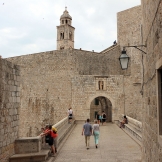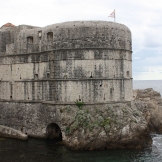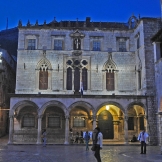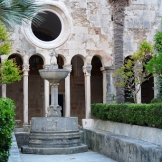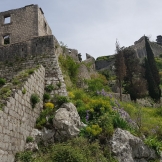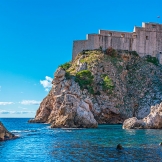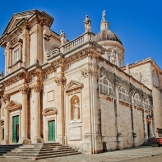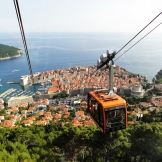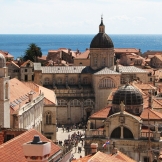Home > Порт "Dubrovnik, Croatia"
Dubrovnik is a cruise port and Adriatic Sea town in Croatia and one of the most famous and popular tourist destinations in Europe.
Dubrovnik's main cruise port is located in the Gruz area, about 3 km from the Old Town. Most cruise ships arrive there, although some dock in front of the city's old port, from where passengers are ferried ashore by boat.
Port address: Obala Ivana Pavla II 1, 20000, Dubrovnik.
Terminals: The port has one cruise terminal in the Gruz area.
Cruises with a visit to this port
How to get there
Attractions
Excursions
Reviews
 Wait a few seconds...
Wait a few seconds...
From Dubrovnik airport to city
- From the airport you can get to Dubrovnik city center by shuttle bus, city bus or taxi.
- The official shuttle that runs between Dubrovnik Airport and the city center is called Atlas Shuttle Bus. One way ticket costs 6 Euros, two way tickets - 10 Euros. On average, the shuttle runs every 1.5 hours from 04:45 to 17:35 or 18:30, depending on the day of the week and the number of flights on a particular day.
- You can also get there by the regular city bus of the Libertas company. This option is more budgetary, but also longer, as the bus has more stops than the shuttle. One way ticket costs 4 Euro. Travel time: about 40-50 minutes.
- You can also book a group transfer from the cruise company with the manager of For Gates Ukraine.
- The best way to order a transfer from the manager of Fort Gates Ukraine (50 Euro / 1-3 passengers).
From the port to the Old Town
The shortest distance between the port and Dubrovnik's old town is 2.5 km. You can take a taxi, take a bus or walk.
- By local bus: On bus line 1, take a bus to Gruz and get off at the Pile stop. From there, just walk across the bridge and go down the stairs to the Stradun, the main waterfront of the Old Town. The bus ride is about 20 minutes one way. It is much shorter than a taxi ride due to the city's one-way system.
- Walk from Gruz to the Old Town: if you have free time, the weather is not too hot, and you do not need to carry heavy luggage, it is best to take a walk from Gruz to the Old Town. You will walk along the marina, where many small boats are at anchor. On the way, you can stop at the local fruit and vegetable market to buy fresh produce. Then you will reach Boninovo, from where magnificent views of the open Adriatic Sea open up to Italy. Another 10 minutes walk and you are in the Old Town.
City walls of Dubrovnik. The imposing walls of Dubrovnik - they allowed the city to be included in the UNESCO list. These white limestone defenses date back to the 600s, but their current form dates back to the 15th century.
Old city. At times, the winding streets of Dubrovnik's old town will feel like a movie set, and you will find that you can develop an appetite if you let your curiosity guide you through all the little alleys. You can orient yourself towards Placa (the main street of old Dubrovnik); a straight and wide limestone canal beneath the great old houses.
Funicular. Undoubtedly, the best view of Dubrovnik is from the summit of Mount Srd, which is 412 meters above the city and a short distance from the coast. In 1969, a cable car was built that served the summit and ran until midnight during the height of the summer months.
Dubrovnik Cathedral. The city cathedral is one of the largest ensembles of Baroque architecture in Dubrovnik. Among the many reasons to visit this diocese site is to see the interior artwork. The main altar contains the triptych of the Assumption of Mary, executed by the Renaissance artist Titian from 1550. On the sides of the church are several other impressive works by Croatian and Italian artists from the same era.
Fort Lovrienac. Fort Lovrienac or Fortress of St. Lawrence, often referred to as the "Gibraltar of Dubrovnik", is a fortress and theater outside the western wall of Dubrovnik, Croatia, 37 meters above sea level. One of Dubrovnik's defenses, Lovrienac earned its place in urban folklore during its long period of struggle against the Venetians.
Fortress of St. John. It is part of the city walls and is located on the southeast side of the defensive structures that protect the port of Dubrovnik. If you look inside the tower, you can visit the small aquarium on the ground floor and then head upstairs to view the maritime museum.
Franciscan monastery. This complex dates back to the 1300s and was moved to the city walls after an earlier monastery was built and then destroyed outside of them. One of the must-see attractions is the monastery's pharmacy, built in 1317, making it one of the oldest still operating pharmacies in the world.
Sponza Palace. This rectangular palace with a beautiful loggia dates back to the early 1500s and has since served as a secular public building. The atrium at the gates of the building was a commercial and commercial place until the 20th century. Today, the palace serves as a city archive containing about 100,000 documents. dated to the X century.
Clock tower. The Dubrovnik Clock Tower, the most famous landmark in Luza Square, is 31 meters high and was built in 1444. On either side of the large bell at the top flanks are two bronze figures "Baro" and "Maro", which hold hammers and form the mechanism that makes the church ring at noon every day.
Church of St. Blaise. An ornate Baroque church replaced the Romanesque building on this site, which was lost in the earthquake. The current structure was built by the Venetian architect Marino Gropelli in the early 1700s.
Orlando Column. In the eastern part of Plaka, right in front of the Church of St. Blaise, is this stone pillar and flagpole that dates back to the 1400s and is the meeting point in the center of the old town. The column is a symbol of Dubrovnik's freedom.
Leave your comment
Comment

